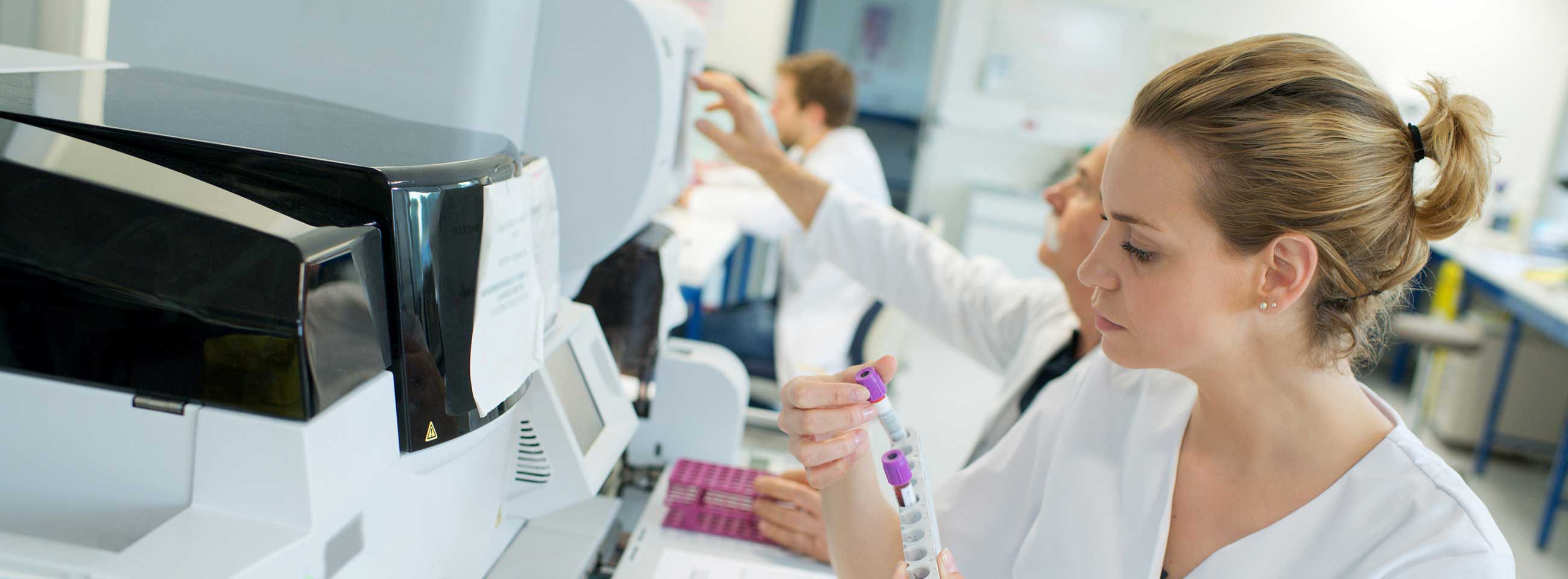Genomic information at the service of human health and its environment
Products
Deeplex® HelP is a culture-free diagnostic assay, for strain type identification, virulence and antibiotic resistance prediction of Helicobacter pylori. This tNGS-based solution, developed by GenoScreen, is design to prevent diseases associated with H. pylori infections such as gastritis, peptic ulcers and cancer.
Available as a kit or as a service, Deeplex® HelP is a comprehensive solution that allows precise characterization of Helicobacter pylori infections and enables clinicians to guide treatment therapies.

Deeplex® HelP Workflow
-
- DNA extraction from a clinical sample or H. pylori culture (step not included in the kit)
- A single multiplex PCR to amplify regions from:
- 8 genes associated with resistance to 6 antibiotics
- 7 genes for for H. pylori typing
- 2 genes coding for virulence factors CagA and VacA
- PCR product clean-up and library preparation
- Sequencing on on Illumina platform
- Data analysis with our automated pipeline
Go beyond Helicobacter pylori detection for effective management of patients infected with H. pylori.
Deeplex® Myc-Lep is an innovative culture-free solution for the prediction of Mycobacterium leprae drug resistance. Directly usable on DNA extracted from skin biopsies and slit-skin smears, it uses targeted next generation sequencing (tNGS) to simultaneously predict (hetero-)resistance of M. leprae to anti-leprosy drugs and identify strain type for epidemiological tracking.
Available as a kit or as a service, Deeplex® Myc-Lep represents a complete solution which facilitates the management of patients with leprosy and enables the control and monitoring of antibiotic-resistant M. leprae strains.
Deeplex® Myc-Lep Workflow
- Extraction of DNA from a clinical sample (step not included in the kit)
- A single-reaction multiplex PCR performed to amplify:
- 7 drug resistance-associated leprae genes
- 1 gene for mycobacterial identification (hsp65)
- 18 canonical SNPs
- 11 core VNTR markers
- PCR product clean-up and library preparation prior to sequencing
- Sequencing data analysis using our automated pipeline
Upon request, the Deeplex® Myc-Lep assay can be performed on your samples at GenoScreen. This service includes all steps, from DNA extraction (optional), to the reporting of results.
Get fast, easy-to-interpret results for effective management of patients infected with leprosy.
The Brucella MLVA-16 typing solution, developed by GenoScreen, enables health authorities to effectively monitor and control cases of brucellosis in both animals and humans as well as Ochrobactrum infections.
Conventional diagnostic techniques struggle to distinguish between Brucella or Ochrobactrum strains due to their close relatedness, leading to a suboptimal disease management1.
Brucella species are not known to survive long in open environments, their exhibit various host tropisms and varying levels of pathogenicity, which can result in brucellosis, a potentially fatal disease in both humans and animals. In contrast, Ochrobactrum species are commonly found in the environment, are less pathogenic and require a different treatment approach for successful eradication1.
The Brucella MLVA-16 typing solution offers a valuable tool for accurately identifying and distinguishing species within both the Brucella and Ochrobactrum genera. This tool enables the effective tracking and management of infections caused by these organisms.
The Brucella MLVA-16 Workflow
- The Brucella MLVA-16 typing solution is available as a service and as a kit.
- The kit contains 4 PCR mixes with fluorochrome-labeled primers, each amplifying 4 VNTR (16 VNTR in total) from purified DNA extracted.
- A positive control is included in the kit to ensure the quality of the results obtained.
- The PCR products are migrated on a capillary sequencer for fragment size determination.
- Fragment sizes are converted bioinformatically into a succession of numbers of repeats for each VNTR, defining a MLVA numerical code specific to Brucella or Ochrobactrum species/strains.
- The MLVA profile can be compared with a database that enables strain identification and tracking.
Brucellosis, a “One Health” challenge
Brucellosis (or Malta fever) is one of the most widespread animal disease transmissible to humans (zoonose) and the first cause of contamination in laboratories. The bacteria are transmitted to humans through direct contact with infected animals, ingestion of contaminated animal products or inhalation of aerosols3.
Animal brucellosis has a broad impact, affecting mammals across the board, with notable consequences in cattle, sheep, and goats. In the agricultural sector, the disease often leads to issues such as abortions, infertility, reduced milk production, resulting in diminished productivity and substantial economic losses for livestock farmers4.
Human brucellosis, on the other hand, presents a pressing public health issue. It manifests with severe and enduring flu-like symptoms that can, in some cases, progress into chronic forms. These chronic forms may entail various complications, including joint problems, cardiac ailments, neurological symptoms, and more3. In 2023, the incidence of human brucellosis is estimated at over 1.6 - 2.1 million cases per year5.
In contrast to high-income countries where effective "test-and-slaughter" policies have nearly eliminated brucellosis in infected herds, low- and middle-income countries continue to grapple with the burden of this disease. Moreover, the increasing global migrations of both humans and animals, along with more frequent interactions between them, has heightened the risk of Brucella infections. This risk includes now the emergence of newly discovered pathogenic strains that may elude existing surveillance programs, posing a worldwide threat to disease containment efforts3.
References:
- Moreno, Edgardo et al. (2023). “If You're Not Confused, You're Not Paying Attention: Ochrobactrum Is Not Brucella.” Journal of clinical microbiology 61(8). https://doi.org/10.1128/jcm.00438-23
- Al Dahouk, Sascha et al. (2007). “Evaluation of Brucella MLVA typing for human brucellosis.” Journal of microbiological methods 69(1) 137-45. https://doi.org/10.1016/j.mimet.2006.12.015
- https://www.who.int/news-room/fact-sheets/detail/brucellosis
- https://www.woah.org/en/disease/brucellosis/
- Laine, C. G., Johnson, V. E., Scott, H. M., & Arenas-Gamboa, A. M. (2023). Global Estimate of Human Brucellosis Incidence. Emerging infectious diseases, 29(9), 1789–1797. https://doi.org/10.3201/eid2909.230052
GenoScreen's MIRU-VNTR typing solution is used by many healthcare centers, CNR and research teams worldwide, both as kits and as service.
MIRU-VNTR, a global reference
The MIRU-VNTR typing
The MIRU-VNTR (Mycobacterial Identification Repetitiv Unit-VNTR) analysis is an MLVA (Multiple Loci VNTR Analysis) analysis scheme specific to Mycobacterium tuberculosis. This is used in the genotyping of strains by numbering copies of VNTR present in 24 identified loci. The targeted VNTR loci are amplified by PCR with a set of primers specific for the flanking regions of each locus. The fragments thus obtained are processed by capillary electrophoresis. This method is the world standard for Mycobacterium tuberculosis typing, adopted by American and European CDCs and reference centers in more than 30 countries.
GenoScreen's MIRU-VNTR solution became the international standard reference for the MIRU-VNTR method (tests performed by RIVM 3, 4). It comes in a range of exclusive kits adapted to each step of the MIRU analysis (Calibration, validation and typing). This complete solution is optimized to deliver the best possible results with a standardized approach, while maintaining high reproducibility.
Learn more about our MIRU-VNTR kits
MIRU-VNTR Hypervariable, a scheme adapted to the strains of the Beijing lineage
M. tuberculosis strains identified as belonging to the so-called "Beijing" lineage cannot be distinguished by using the standard 24 loci. The sub-lineages in this family are identified by a MIRU analysis using a set of 4 additional hypervariables VNTR loci 1, 2. The MIRU-VNTR Hypervariable kit from GenoScreen enables this additional targeted analysis to be carried out.
GenoScreen's MIRU-VNTR solution is also available in a range specially designed for this complementary targeted analysis. The MIRU-VNTR Hypervariable kits (calibration, validation and typing) allow this specific typing, while benefiting from the same results quality and reproducibility as our MIRU-VNTR solution.
Learn more about our MIRU-VNTR Hypervariable kits
GenoScreen's expertise
With its cutting-edge technological expertise, GenoScreen is currently the leader worldwide in the genotyping and tracing of the Mycobacterium tuberculosis complex strains, the agent responsible for tuberculosis.
As kit or service packages, our solutions can be adapted to all issues:
- Research: structure of the strain population, evolution, comparison of virulence properties
- Public health: tuberculosis control and epidemiological surveillance
- Clinical trials: distinction between relapse and exogenous infection in case of treatment failure
- Clinical management: detection of cross-contamination, discrimination of close-related strains (clonal complexity)
The MIRU range, a complete offer
We propose kits and training for the implementation and use of the MIRU-VNTR method on Applied Biosystems® sequencers.
| MIRU-VNTR | Calibration kit | 1 calibration of Applied Biosystems® capillary sequencer and GeneMapper® software |
|---|---|---|
| Validation kit | 1 validation of the Applied Biosystems® capillary sequencer and GeneMapper® software settings | |
| Typing kit 24 markers according to international standard | 100 reactions (PCR + migration on Applied Biosystems® capillary sequencer) | |
| MIRU-VNTR hypervariable | Calibration kit | 1 calibration of Applied Biosystems® capillary sequencer and GeneMapper® software |
| Validation kit | 1 validation of the Applied Biosystems® capillary sequencer and GeneMapper® software settings | |
| Second line typing kit (4 markers) adapted to Beijing line strains | 50 reactions (PCR + migration on Applied Biosystems® capillary sequencer) | |
| MIRU-VNTR typing as service | Standard or customized schematics to meet your requirements | From DNA extracted (50 ng) or 50 µL of thermolysat on Applied Biosystems® capillary sequencer |
Calibration kit
Calibration of the analysis software and capillary sequencer is an essential preliminary step in the use of the GenoScreen MIRU-VNTR kit. We recommend a calibration of each sequencer and at each capillary change.
The MIRU-VNTR calibration kit contains: 14 reference DNA, 1 positive control (BCG), 6 master mixes (for the 24 VNTR loci), and an allelic ladder.
It provides calibration of one Applied Biosystems® 3730, 3500, 3100 or 3130 capillary sequencer.

The validation kit
The validation kit is used to validate the sequencer and software calibration over time. It is part of the quality control of the equipment.
The MIRU-VNTR validation kit contains: 14 reference DNA, 1 positive control (BCG) and 6 master mixes (for the 24 VNTR loci).
It provides the ability to validate the calibration of one Applied Biosystems® 3730, 3500, 3100 or 3130 capillary sequencer.

The 24 loci typing kit
The MIRU-VNTR typing kits contain the reagents necessary to perform MIRU typing on 24 VNTR loci, in accordance with the international standard. This kit allows analysis with a small amount of DNA and ensures a high rate of reproducibility of results.
The kit contains: a positive control (BCG) and 6 master mixes allowing the amplification of the 24 targeted VNTR loci.
It allows to run 100 tests on a previously calibrated Applied Biosystems® 3730, 3500, 3100 or 3130 capillary sequencer.

List of VNTR loci targeted by MIRU-VNTR 24-loci typing
| Loci | Alias | Loci | Alias | Loci | Alias | Loci | Alias |
|---|---|---|---|---|---|---|---|
| 154 | MIRU02 | 1644 | MIRU16 | 2401 | Mtub30 | 3171 | Mtub34 |
| 424 | Mtub04 | 1955 | Mtub21 | 2461 | ETRB | 3192 | Mtub34 |
| 577 | ETRC | 2059 | MIRU20 | 2531 | MIRU23 | 3690 | Mtub39 |
| 580 | MIRU04 | 2163b | QUB11b | 2687 | MIRU24 | 4052 | QUB26 |
| 802 | MIRU40 | 2165 | ETRA | 2996 | MIRU26 | 4156 | QUB4156 |
| 960 | MIRU10 | 2347 | Mtub29 | 3007 | MIRU27 | 4348 | MIRU39 |
The hypervariable calibration kit
Calibration of the analysis software and capillary sequencer is an essential preliminary step in the use of the GenoScreen MIRU-VNTR Hypervariable kit. We recommend a calibration of each sequencer and at each capillary change.
The MIRU-VNTR Hypervariable calibration kit contains: 6 reference DNA, 1 positive control (BCG), 1 master mix (for the 4 loci), and an allelic scale (ladder).
It provides calibration of one Applied Biosystems® 3730, 3500, 3100 or 3130 capillary sequencer.

The hypervariable validation kit
The validation kit allows to validate the sequencer and software calibration over time. It is part of the quality control of the equipment.
The MIRU-VNTR Hypervariable validation kit contains: 6 reference DNA, 1 positive control (BCG), and 1 master mix (for the 4 loci).
It provides the ability to validate the calibration of an Applied Biosystems® 3730, 3500, 3100 or 3130 capillary sequencer.

The hypervariable typing kit
The hypervariable MIRU-VNTR typing kit contains the reagents required to achieve MIRU typing on the additional 4 VNTR loci for differentiating Beijing sublines from each other. This kit allows accurate analysis with a small amount of DNA and ensures a high rate of reproducibility.
The kit contains: a positive control (BCG) and the master mix allowing the amplification of the 4 targeted VNTR loci.
It allows to run 50 tests on a previously calibrated Applied Biosystems® 3730, 3500, 3100 or 3130 capillary sequencer.

List of VNTR loci targeted by MIRU-VNTR Hypervariable typing 3, 4 :
| Loci | 1982 | 3820 | 3232 | 4120 |
|---|
Service provision
We also perform standard and customized MIRU-VNTR analyses as a service provider. We perform MIRU analyses on 9, 12, 15 or 24 standard VNTR markers and/or on the 4 loci dedicated to the Beijing lineage.
Available from 50 ng of extracted DNA (5 μL to 10 ng/µL) or 50 µL of thermolysate, our services include:
- PCR(s) realization ( according to the selected markers)
- PCR product migration on capillary sequencer
- Data analysis on GeneMapper
- Lineage assignment using the MIRU-VNTRplus database
Our training courses
GenoScreen created a complete training program dedicated to the MIRU-VNTR method. From the methodology to the results analysis, including the kits use and the sequencer calibration, these trainings will enable you to easily implement and/or perform the MIRU-VNTR analysis on a routine basis in your laboratory.
MIRU-VNTR training course :
- Theoretical aspects: the premise of the MIRU-VNTR typing method
- Practical aspects: training in the MIRU-VNTR kits use
- Implementation: training in the Applied Biosystems® sequencer calibration
- Data import & analysis: training in the GeneMapper® software use
- Data mining: training in the MIRU-VNTRplus analysis tool use
Références
1 Allix-Béguec C, Wahl C, Hanekom M, Nikolayevskyy V, Drobniewski F, Maeda S, Campos-Herrero I, Mokrousov I, Niemann S, Kontsevaya I, Rastogi N, Samper S, Sng LH, Warren RM, Supply P. Proposal of a consensus set of hypervariable mycobacterial interspersed repetitive-unit-variable-number tandem-repeat loci for subtyping of Mycobacterium tuberculosis Beijing isolates. J Clin Microbiol. 2014 Jan;52(1):164-72.
2 Trovato A, Tafaj S, Battaglia S, Alagna R, Bardhi D, Kapisyzi P, Bala S, Haldeda M, Borroni E, Hafizi H, Cirillo DM. Implementation of a Consensus Set of Hypervariable Mycobacterial Interspersed Repetitive-Unit-Variable-Number Tandem-Repeat Loci in Mycobacterium tuberculosis. Molecular Epidemiology. J Clin Microbiol. 2016 Feb;54(2):478-82.
3 de Beer JL, Kremer K, Ködmön C, Supply P, van Soolingen D; Global Network for the Molecular Surveillance of Tuberculosis 2009. First worldwide proficiency study on variable-number tandem-repeat typing of Mycobacterium tuberculosis complex strains. J Clin Microbiol., 2012 Mar;50(3):662-9
4 de Beer JL, Ködmön C, van Ingen J, Supply P, van Soolingen D; Global Network for Molecular Surveillance of Tuberculosis 2010. Second worldwide proficiency study on variable number of tandem repeats typing of Mycobacterium tuberculosis complex. Int J Tuberc Lung Dis., 2014 May;18(5):594-600
Deeplex® Myc-TB is an all-in-one test for species-level identification, genotyping and prediction of antibiotic resistance in Mycobacterium tuberculosis complex strains. As the first ever tool to exploit in-depth DNA sequencing technology and thus detect and analyze antibiotic resistance, Deeplex® Myc-TB detects mutations responsible of antituberculosis drugs resistance.
A rapid and precise characterization
Based on next-generation sequencing, Deeplex® Myc-TB includes a targeted amplification kit that can be used directly on clinical samples, with no need for a culture step, in less than 48 hours.
Deeplex® Myc-TB also provides typing information on the strain involved which is useful for epidemiological surveillance and facilitates the identification of other bacterial pathogens from the same genus.
Deeplex® Myc-TB also includes an easy-to-use web application (hosted on a secure cloud digital platform) for the analysis and rapid interpretation of the results.
GenoScreen also commercializes other exclusive kits and services worldwide for the identification and typing of tuberculosis strains via the internationally standardized MIRU-VNTR. These solutions are used in epidemiological surveillance and for the detection of tuberculosis epidemics or other events (such as patient reinfections and laboratory contaminations). They are backed up by high-precision genome analysis services.
Deeplex® Myc-TB Workflow
- Directly applicable to clinical samples
- Simultaneous prediction of resistance to 15 anti-TB drugs
- MTBC hetero-resistance down to 3%
- MTBC spoligotyping and genotyping
- Identification of more than 100 mycobacterial species (NTM)
- Quick turnaround time of about 48 hours
- Multiplexing of up to 384 samples
Download the technical note:
Deeplex® is registered as a trademark in the USA (number 4980234) and in other countries.
The design of the visualization of the results in the Deeplex® web application is registered in the USA (number 890,770) and in other countries.
News
-
Updated guidelines for Novel Food submissions (EU) 2015/2283
The 1st of February 2025 entered into force the “Guidance on the scientific requirements for an application of a novel food in the context of Regulation (EU) 2015/2283”.
-
What is EFSA?
EFSA stands for the European Food Safety Authority. It is essentially the scientific supervisor of the European Union when it comes to food. EFSA’s purpose is to ensure that the food Europeans eat is safe and meets high quality standards. To do so, they provide objective and unbiased scientific...
-
How to preserve the skin microbiota?
The skin microbiota plays a vital role in maintaining the skin's integrity and functionality. It contributes to the proper regulation of organisms and organs, allowing the skin to perform its essential functions, including acting as a barrier. See our latest article "Why preservce the skin...











